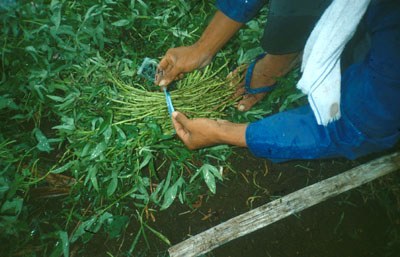|
Sweetpotato
planting material is either obtained from vine cuttings, the most common source,
or from storage roots.
Use
of stem cuttings. Farmers obtain cuttings from an established crop before
or just after the harvest of storage roots. The cuttings are either used to
establish a maintenance field, or directly for planting the next sweetpotato
crop.
Below are some factors affecting yield, when using stem cuttings:
-
Generally
the apical portion of the vine is better than the middle or basal
portions. This portion is less likely to carry sweetpotato weevils and
fungal pathogens, and has been found to establish faster than other
portions. For cultivars with long vines, the second or third cut is
acceptable. Sometimes, the second cutting is better than the apical
portion, if vine growth has been so fast that the stem has not matured in
the apical portion.
-
Usually
one-third to two-thirds of the cutting is buried. A minimum of 2-3 nodes,
but up to about 8 nodes, is placed under the soil. The effect of number of
buried nodes on the final yield is inconsistent among reported studies,
but may depend on the plant density, with lower number of nodes being
acceptable at higher plant density.
-
The delay
between cutting and planting may affect yield depending on the storage
conditions for the cuttings. Storing cuttings for one to two days in humid
conditions may be beneficial, promoting rooting at the nodes. Longer
storage may adversely affect establishment by exhaustion of the cuttings’
energy reserves. To minimize losses, leaves should be stripped from the
lower portion of the cutting, and bundles of cuttings wrapped in a wet
cloth or sack and kept in a cool, shady place away from wind. If roots
develop during storage, they should be planted carefully to minimize
damage to the roots.
If planting material is to be maintained in a multiplication plot before
planting of the next crop, plant cuttings at approximately 15 x 20 cm spacing.
New growth may be ready for cutting after 45 days.
Use
of storage roots. Storage roots are used when there are insufficient
stem cuttings available, or when the level of pest and disease infestation is
high so that few healthy vines are left. They may also be used in highly
mechanized production, as the sprouts can be harvested mechanically from the
seedbed.
Rapid
seed multiplication. When large amounts of cuttings are needed,
rapid multiplication may be done. Although the merit of this practice has not
been fully acknowledged by sweetpotato growers, it can be the easiest way to
produce large amount of planting materials. This method involves the following
steps:
- Cuttings of about 30 cm are taken from either established plants or
sprouted storage roots. These are then cut into single node cuttings, with
the leaf attached. The tip of the vine is discarded.
- A seedbed is prepared with a mixture of loose, humus-rich soil and rice
hull ash. The single-node cuttings are planted at a high density, with the
stem section buried and the leaf upright.
- The seedbed is regularly watered and is prevented from drying especially
during the first week of establishment.
- After about two weeks, the seedlings have developed enough roots to be
transplanted into the field. They should be removed from the seedbed with
care to avoid damaging the roots. Transplanting should be done in the late
afternoon to avoid excessive evaporation and wilting.
Degeneration of planting material
When sweetpotato is vegetatively propagated for a number of generations,
yield decline is often observed. This is usually due to a build-up of viruses,
many of which show no obvious symptoms. This often gives the impression that a
new variety (carrying few viruses) yields much better than traditional
varieties, when in fact it may be no better after a year or two when viruses
have accumulated.
Viruses can be removed by heat treatment and meristem culture. This process
usually results in a yield increase of both vines and roots, from 20% to 200%,
depending on the severity of the original virus infestation. The higher yield
may be maintained for several years in the field, before the virus load has
built up again.
A program in China has significantly boosted regional yields by supplying
farmers with clean planting material regularly. Such a system is the standard
practice for Irish/white potato production, but is not yet widely used for
sweetpotato.
References
Rasco,
E.T., Jr. and Amante, V. 2000. Sweetpotato in Tropical Asia. SAPPRAD-PCARRD.
230 p.
van
de Fliert, E. and Braun, A. 1999. Farmer field school for integrated crop
management of sweetpotato. Field guides and technical
manual. International Potato Center. Lima, Peru. 266 p.
Contributed
by:
Vilma Amante and
Jane
O'Sullivan |
Land
preparation
Planting
Soil
management
Water
management
Vine
lifting
Integrated
pest management
Harvesting
Postharvest
practices

Stem
cuttings for planting (V. Amante).

Storage
roots are used as source of planting materials (E. Data).

Seedboxes
planted from single node cuttings (E. van de Fliert). |

